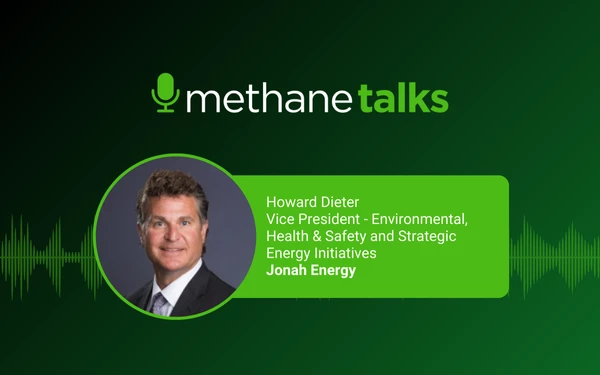Electrifying Oilfield Operations to Reduce Emissions at BPX
Add bookmark
Electrification of industrial operations offers a path to reduce carbon emissions and BPX energy, the US onshore oil and gas business of supermajor bp, is well on its way.
Since its acquisition of BHP assets in the region in 2018, the company has significantly reduced methane intensity per barrel and electrified 80% of its Permian operations.
It is aiming to go further this year: the company has set a target of 95% of its Permian Basin operations to be electrified by the end of 2023.
“Our strategy is a great example of what delivering a better barrel looks like,” says Kim Krieger, Chief Operating Officer - Production at BPX Energy. “We are not only delivering secure and reliable energy to the world, but it's also lower carbon.”
In this interview, ahead of our Methane Mitigation Global Summit, Krieger shares the company's progress, lessons learned during the electrification of the Permian Basin, and offers insight into the company’s “multi-layered” approach to reducing its methane emissions.
Diana Davis, IX Network: I understand that you're heavily investing in electrifying your Permian Basin operations. Can you tell us more about what you're doing?
Kimberly Krieger, BPX: BPX is in the process of electrifying all aspects of our operations from the development and construction of new facilities and pads to production operations. We are also building our own electric substation network, which can power our entire Permian asset operation.
This infrastructure is exciting because of its scale: it can power nearly all the residential homes in Austin, and it happens to be our grid and our network that we've built to support Permian.
Diana Davis, IX Network: Why did you decide to embark on that journey?
Kimberly Krieger, BPX: There are a couple of reasons. Electricity is clearly the cleanest, most efficient, reliable, and cost-effective means of distributing power in the oil field. Investing to build the high voltage electrical infrastructure allows us to do several things for emissions reduction. It also improves our uptime because you're able to reduce your dependency on natural gas driven engines.
Today, we currently offset all our electric consumption through the purchase of RECs - renewable energy credits.
We're also working to further reduce our emissions by actively sourcing renewable energy as it is developed in the region. The Permian is growing in both oil and gas as well as renewable sources.
We’re looking at opportunities for behind the meter projects with companies such as Lightsource BP, our own utility scale solar power business.
WATCH: On-Demand Webinar: Critical Considerations for Building Your Methane Mitigation Strategy
Diana Davis, IX Network: What have been the challenges along the way?
Kimberly Krieger, BPX: Any new project has its challenges because you're learning and growing. We started electrifying our well sites and then our central facilities. The grid was aimed at supplying power to those sources, and they need reliable energy sources.
Then we started to electrify the drilling rigs and now we're working on electric frac spreads. When you think about everything you are powering, you want to have the highest level of reliability, but you are also adding intermittent types of power loads to the grid. When you power up a frac spread, for instance, it is an instantaneous heavy load. Similarly, at various times during drilling operations, you're pulling an incremental load.
That was one of the big challenges: the engineering and design required to make sure that we can handle variable loads while still getting steady power to our wells and facilities fed by the grid.
But it has been a fun challenge. Our team has enjoyed reimagining what we've been doing in the industry for many years but using an electric source to make it happen.
Diana Davis, IX Network: What did it take to overcome that challenge? What are the key learnings that you take from the project?
Kimberly Krieger, BPX: One of the key points was putting redundancy in the system and related design features on the grid. We have got two substations in the field already, for instance.
If you're looking to electrify, you need to build the resources and the capability whether you build it within your own company or work with third party firms who carry it as a core part of their expertise. We found it helpful to bring together a new, integrated team to look at the modeling and location of the loads so that you get the system design for reliability and the flexibility.
Diana Davis, IX Network: What kind of results have you had? What has been the impact on your emissions?
Kimberly Krieger, BPX: Since we have been running our drilling rigs on grid power, we have been able to eliminate nearly all the emissions that would have been used from diesel fuel. Oil rigs are big consumers of diesel fuel. In the Permian, we drill several wells on one pad, so we were able to save 430,000 gallons of diesel on just one multi-well pad by feeding the rig from our grid.
We’re also looking at powering the frac spreads out in the Permian as well. They were run off diesel traditionally and there are hybrid fleets now. This solution will also greatly reduce emissions.
By electrifying our production well pads, we've been able to replace what would have been the natural gas supply to our pneumatic controllers with air compressors that are run off the grid. That means we're able to run our pneumatics with air versus fuel gas. Eliminating methane emissions from our pneumatics in the Permian has greatly reduced emissions for us.
Diana Davis, IX Network: I’m glad you mentioned methane because you’re going to be speaking at our upcoming Methane Mitigation Global Summit later this month in Houston. Would you give us a bit of an overview of your approach to methane emissions?
Kimberly Krieger, BPX: Our strategy is a great example of what delivering a better barrel looks like. We are not only delivering secure and reliable energy to the world, but it's also low carboner.
We are proud of the progress we're making in several areas.
First, we've reduced our methane intensity from 4% in 2019 to less than 1% today. We're now consistently achieving below 1% - among the lowest compared to our peers in the Permian.
We're also reducing our flaring. Since we've acquired the assets from the prior operator in the Permian in 2018, our routine flaring intensity has dropped by 95%. It was 16% in 2019, and now we're consistently less than half a percent.
As I mentioned earlier, we've got 400 megawatts of capacity now in our system and we're growing that to 800 megawatts by 2025. Electrification is a huge part of our plan.
Finally, we're certifying our gas. All the natural gas produced from our facilities has undergone a certification using the MiQ methane standard. The process was taken with an accredited third-party auditor and the certification of each facility provides a granular assessment and grade for our methane emissions. Performance is based on our methane intensity, our company practices, and our technology deployment.
We're excited to see BP’s strategy of reimagining hydrocarbons coming to life on these metrics.
Diana Davis, IX Network: What would you say has been the highest impact action that you've taken to achieve those results?
Kimberly Krieger, BPX: It’s twofold: first, electrification has made a huge impact as it has allowed us to make differential equipment choices that have a lower emitting footprint. Right now, we’re sourcing the power through RECs and we're working on solar as a solution, ultimately.
Secondly, I think being able to build infield gathering and central facilities has been important. It has allowed us to take and address the smaller emissions that were aggregated out at all the facilities into the plant.
For example, our Grand Slam facility in the Permian - our first central facility - is so efficient at catching all the flash gas from the process that we sell more gas from the facility than we bring in because we're pulling it off our produced water and other sources of flash.
We're usually able to sell about 5% more gas out of that facility that otherwise would have been combusted with a legacy type design.
Diana Davis, IX Network: At last year’s Decarbonizing Oil and Gas Summit, one of your colleagues, Dr Faye Gerard, talked about how BP X was looking to move from a “find and fix” to a “predict and fix” approach to methane leak detection and repair. Where is BPX with this now?
Kimberly Krieger, BPX: I'm glad Faye was able to share our progress with the group last year because it is another space where I think everybody's learning and working to improve.
We started by setting high standards for ourselves and ultimately, those high standards apply for the industry as a whole. As a corporation, we have laid out plans to achieve zero routine flaring across all our operations by 2025. We are currently well ahead of this schedule.
We've also committed to a 50% reduction on our emissions from our operations by 2025.
To achieve these commitments, it’s essential to solve for intermittent emissions. We're working on that as we work towards continuous measurement on our sites.
In some instances, emissions detected during advanced measurement surveys can be intermittent, and that means that although the survey caught it, they're not necessarily persistent beyond the duration of the survey itself.
We’re looking at a host of technologies that can help deal with these intermittent emissions. It’s a new space and we are trying different approaches before narrowing it down to what we think is the most effective.
We are keeping a broad set of technologies in our portfolio now. We're doing fixed wing aerial surveys. We're using drones and trialing continuous on-site monitoring and even satellite technologies.
For instance, we fly our entire Permian asset monthly. We use Kairos aerospace to detect and measure methane emissions from their fixed wing aircraft. We deploy commercial drones with laser mounted detection twice monthly to look for emission sources.
We have also stood up dedicated teams in all our basins emissions management teams, which function independently of our daily production operations. These teams utilize all the detection data that we gather, and they become our rapid response team to find it. Often, they're both correcting and learning to predict based on what they're finding.
This multi-layered approach is improving our emissions performance and it is shaping engineering projects that really allow us to deliver programmatic type changes and sustainable improvement. If we find that we need to fix one thing on one site, there's a chance that there are dozens of sites that could benefit from the same change.
What I'm also really excited about are the continuous measurement technologies on the well sites. While we still have more work to do, we have a clear path that we've set out to install continuous measurement on all our major oil and gas sites this year.
Interested in learning more about this topic?
Kim Krieger will be speaking at our upcoming Methane Mitigation Global Summit. Join her and over 300 international oil and gas leaders on June 20-23, 2023, in Houston. You'll learn how methane reduction is being shaped by the global regulatory landscape, understand the key pathways to lowering emissions, discover how to build innovative partnerships to accelerate abatement efforts and explore how to improve the reliability and credibility of methane emissions data. Download the event agenda for more information.




















